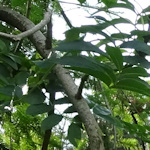
The Palmenhaus in the Schönbrunn Palace park is a giant palm house with the kind of shrubs and trees you’d expect from a monumental glasshouse managed by the experts of the Austrian Federal Gardens.
- Built in 1882 under Emperor Franz Joseph
- Around 111m long, 28m wide and 25m high
- Includes a tropical section with various fruit trees
- Often decorated with colourful flower displays
- Take all the paths inside for little surprises
- Book a Schönbrunn concert, tour & more*
- See also:
Inside the palm house

(The Schönbrunn palm house as shown on this section of a postcard from around 1898 manufactured by C. Ledermann jun.; Sammlung Wien Museum; reproduced with permission under the terms of the CC0 licence)
At the time of its 1882 construction, the Schönbrunn palm house was the largest of its kind. According to newspaper reports, Emperor Franz Joseph visited the new building at 2pm on June 17th of that year for a tour led by, among others, architect Franz Segenschmid.
The builders – Firma Ignaz Gridl – survive today, albeit under a different name: Waagner Biro bought up the original company in 1934 and helped repair, for example, the roof of Stephansdom cathedral in Vienna’s city centre after WWII.
The company still contributes to iconic buildings, such as the roof of the Louvre Abu Dhabi or the dome of London’s “Gherkin”. They even renovated some of the stage systems at Vienna’s State Opera House.
Rather aptly, Waagner Biro also helped with the Schönbrunn palm house’s renovation back in 1990.
(Find tickets and experience options for the palace and zoo)
After you pass through the main entrance, you find yourself in the middle section (the largest) consisting of a temperate, Mediterranean climate with suitable specimens.
Go to the right to eventually reach the tropical section at one end of the building. Or go left to eventually reach the “cold” section at the other end.
The huge palms that give the building its name dominate that first central part. The federal garden service usually enhances the trees and shrubs with pot plants around a theme or exhibition topic.
So a blaze of colour might well greet you as you walk in through the entrance and throughout the building; on my visit one May, hydrangeas and lilies popped up everywhere.
Be sure to explore the paths leading off toward the sides of the building; they reveal such mini delights as a carnivorous plant section (featuring a selection of the hundreds of “flesh-eating” plants in the wider collection maintained by the authorities).

(A view inside the Palmenhaus on a postcard from around 1910, as painted by Rudolf Konopa and produced by Brüder Kohn KG (B. K. W. I.); Wien Museum Inv.-Nr. 157487; excerpt reproduced with permission under the terms of the CC0 licence)
The real highlights grow in the tropical section. For example:
- Two plants with absolutely enormous leaves: a Lodoicea palm (Coco de Mer) and Ravenala madagascariensis (the Traveler’s Palm)
- Various plants you recognise from supermarket shelves, but may never have seen before, such as…
- A banana “tree”
- The vanilla orchid
- A lychee tree
- A fig tree
- Cacao tree (chocolate!)
- A star fruit tree
- A papaya tree
- An African oil palm tree (the source of the infamous palm oil)
The English names did not appear on plant labels on my last visit, so take your botanical dictionary with you (or a smartphone).
Tickets & visitor tips
At the time of writing, a standard adult ticket cost €9, with the palm house opening daily all through the year.
- Frequent seats and benches mean you can sit down and enjoy the atmosphere immersed in tropical greenery
- The tropical section is warm and wet: watch your camera when taking photos upwards as drops of water fall down regularly
- It won’t take much more than 30 minutes to get around, even if you dawdle
If you visit and like your hothouse botany, you might also consider:
- The Butterfly house in central Vienna’s Hofburg complex and Burggarten park (not huge but has gorgeous butterflies)
- The palm house at Hirschstetten (smaller than the Schönbrunn version and a bit out of the way, though the surrounding gardens have a lot to offer, too)
Since you’re practically next door to it, spare a moment for Schönbrunn’s small Japanese garden as well.
The palm house also sits opposite the desert house and just up from the famous Schönbrunn zoo. And, of course, all of this is embedded in the wider Schönbrunn park and landscaped gardens.
How to get to the palm house
Just go to the article with directions to Schönbrunn and follow the instructions given under the section, “Hietzing station”.
Address: Schlosspark Schönbrunn, 1130 Vienna | Website